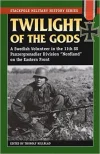Aivan oikea vastaus, nopeasti kuten odotinkin. Paskamainen loppu kaikkiaan:
"For the 50-man crew aboard submarines like the
U-1206, life wasn’t just extremely dangerous, it was also very unpleasant: Quarters were cramped, and the bathrooms were no exception. There were only two
heads (toilets), and because one of the heads was right next to the galley, the space was often used to store food. When it was, the toilet was unavailable, meaning the entire crew had to share the remaining toilet.
UNDER PRESSURE
The plumbing on German subs of that era differed from American and British subs in one important respect: The German toilets discharged their contents directly into the sea, instead of in a holding tank. Not having such a tank saved precious space, but it came at a price. The toilets could only be used when the submarine was traveling on or near the ocean surface. When the submarine was submerged, the pressure outside the hull was too great for the toilets to be able to flush.
If nature called under such circumstances, crew members had to use buckets, tin cans, or whatever other containers they could get their hands on. They had to carefully store the contents of all those containers -don’t spill!- until the submarine surfaced, when they could be poured into the toilets and flushed, or taken topside and emptied into the sea.
The ventilation systems on World War II German subs were notoriously inadequate, which meant that even in the best of circumstances, the air was foul with diesel fumes, human body odor, and other smells. When the toilets were unavailable and all those buckets and cans were filling to overflowing with you-know-what, the stench was even worse.
HEADS UP!
The
U-1206 had a new-and-improved plumbing system. Unlike many subs in the fleet, it had high-pressure toilets that could be used at greater depths than the standard heads could. But the new system was very difficult to operate. The toilets came with complicated instructions manuals, and a few members of the crew had to be trained so that they could serve a toilet-flushing “specialists.”
Barely a week into the
U-1206’s first patrol, Captain Karl Adolf Schlitt (who was commanding a sub for the first time), had to use the head while the sub was cruising at a depth of 200 feet, some eight miles off the coast of Scotland. Rather than request the assistance of the toilet specialist, Schlitt tried to follow the instructions in the manual to flush the toilet himself. Something went wrong -and when Schlitt asked the toilet specialist for help, something went wrong again. The specialist opened the outside valve -the one that opened to the sea- while the inside valve was open, causing a torrent of water to flood into the sub.
WHAT A GAS
It was then that another flaw in the
U-1206’s design became apparent. When the submarine is submerged, it runs on electric motors powered by a giant bank of batteries. And the
U-1206’s batteries were in a compartment directly below the malfunctioning toilet. The seawater quickly combined with battery acid and created deadly chlorine gas, which began to spread throughout the sub.
As the gas filled the submarine, Schlitt had no choice but to order the submarine to surface so that the gas could be vented and replaced with breathable air. Because they surfaced within sight of the Scottish coastline, they were quickly spotted by Allied aircraft and attacked. One crew member died in the melee that followed; three others fell overboard and drowned.
The
U-1206 was badly damaged in the attack and could not dive. Seeing no way to save his submarine, Captain Schlitt ordered the crew into the lifeboats; then he scuttled the ship, making it the only warship in naval history to be doomed by its own malfunctioning toilet. Thirty-six members of the crew were rescued by small boats in the area; ten others made it to shore in their lifeboats and were captured."
http://www.neatorama.com/2014/04/28/The-Toilet-that-Sank-the-U-1206/
Bodyguard, lava on vapaa!



